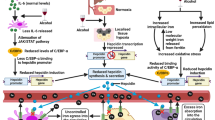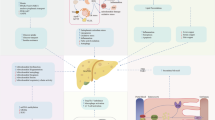Abstract
Background
Obesity is not only associated with nonalcoholic fatty liver disease (NAFLD) but it also adversely affects the progression of other liver diseases. There are limited data regarding the dietary habits of patients with chronic liver disease.
Methods
Nutrition surveys containing 13 different food groups were mailed. Nutrition scores were calculated based on weekly servings. Foods were also divided into USDA food pyramid categories with conversion of each group into calories expended. Clinico-demographic data were available. NAFLD patients were compared to patients with chronic viral hepatitis.
Results
A total of 233 subjects were included: age 52.5 ± 10.0 years, Body mass index (BMI) 28.1 ± 6.5, MS 24.2%, 31.8% NAFLD, 48.1% hepatitis C virus (HCV), and 20.2% hepatitis B virus (HBV). Six nutrition indices were different among the groups. NAFLD and HCV consumed more low-nutrient food (p = 0.0037 and 0.0011) and more high-sodium food than HBV (p = 0.0052 and 0.0161). Multivariate analysis showed that NAFLD and HCV consumed more high-fat sources of meat/protein than HBV (p = 0.0887 and 0.0626). NAFLD patients consumed less calories from fruits compared to HCV and HBV patients (p = 0.0273 and 0.0023). Nine nutrition indices differed according to BMI. Univariate analysis showed that obese/overweight patients consumed more high-fat sources of meat/protein (p = 0.0078 and 0.0149) and more high-sodium foods (p = 0.0089 and 0.0062) compared to the normal-weight patients. In multivariate analysis, normal-weight patients consumed more fruits than obese (p = 0.0307). Overweight patients also consumed more calories of meat and oil than normal-weight patients (p = 0.0185 and 0.0287).
Conclusion
NAFLD and HCV patients have similar dietary habits. Patients with HBV have the healthiest dietary habits. Specific dietary interventions should focus on decreasing intake of low-nutrient and high-sodium food, as well as high-fat sources of meat/protein.
Similar content being viewed by others
References
Neuschwander-Tetri BA, Caldwell SH. Nonalcoholic steatohepatitis: summary of an AASLD single topic conference. Hepatology. 2003;37:1202–9.
Marchesini G, Brizi M, Morselli-Labate AM, Bianchi G, Bugianesi E, McCullough AJ, et al. Association of nonalcoholic fatty liver disease with insulin resistance. Am J Med. 1999;107:450–5.
Poustchi H, Negro F, Hui J, Cua IHY, Brandt LR, Kench JG, et al. Insulin resistance and response to therapy in patients infected with chronic hepatitis C virus genotypes 2 and 3. J Hepatology. 2008;48:28–34.
Bondini S, Kallman J, Wheeler A, Prakash S, Gramlich T, Jondle DM, Younossi ZM. Impact of non-alcoholic fatty liver disease on chronic hepatitis B. Liver International. 2007;27:607–11.
Bondini S, Younossi ZM. Non-alcoholic fatty liver disease and hepatitis C infection. Minerva Gastroenterol Dietol. 2006;52:135–43.
Zelber-Sagi S, Nitzan-Kaluski D, Goldsmith R, Webb M, Blendis L, Halpern Z, et al. Long term nutritional intake and the risk for non-alcoholic fatty liver disease (NAFLD): a population based study. J Hepatol. 2007;47(5):711–7.
Cortez-Pinto H, Jesus L, Barros H, Lopes C, Moura MC, Camilo ME. How different is dietary pattern in non-alcoholic steatohepatitis patients? Clin Nutr. 2006;25:816–23.
Musso G, Gambino R, De Michieli F, Cassader M, Rizzetto M, Durazzo M, et al. Dietary habits and their relations to insulin resistance and postprandial lipemia in nonalcoholic steatohepatitis. Hepatology. 2003;37:909–16.
McDevitt RM, Scott SJ, Harding M, Coward WA, Bluck LJ, Prentice AM. De novo lipogenesis during controlled overfeeding with sucrose or glucose in lean and obese women. Am J Clin Nutr. 2001;74:737–46.
Solga S, Alkhuraishe AR, Clark JM, Torbenson M, Greenwald A, Diehl AM, et al. Dietary composition and nonalcoholic fatty liver disease. Dig Dis Sci. 2004;49:1578–83.
Wang D, Wei Y, Pagliassotti MJ. Saturated fatty acids promote endoplasmic reticulum stress and liver injury in rats with hepatic steatosis. Endocrinology. 2006;147(2);943–51.
Wendland BE. Nutritional guidelines for persons infected with the hepatitis C virus: a review of the literature. Can J Diet Pract Res. 2001;62(1):7–15.
Acknowledgments
This study has been supported by the Liver Disease Outcomes fund of the Center for Liver Diseases at Inova Fairfax Hospital, Inova Health System.
Author information
Authors and Affiliations
Corresponding author
Rights and permissions
About this article
Cite this article
Kim, C.H., Kallman, J.B., Bai, C. et al. Nutritional Assessments of Patients with Non-alcoholic Fatty Liver Disease. OBES SURG 20, 154–160 (2010). https://doi.org/10.1007/s11695-008-9549-0
Received:
Accepted:
Published:
Issue Date:
DOI: https://doi.org/10.1007/s11695-008-9549-0




